Runnymede and Magna Carta
The lead up to June 1215
The Dukes of Normandy
When William, Duke of Normandy took control of the English Crown, he gave his loyal knights earldoms and vast estates in England. The King ruled by 'vis et voluntas' which means 'by force and will'. This was in a period where the Feudal System governed people's lives, whereby land was held in exchange for labour services. The King would receive taxes from the vast estates held by his Barons, as well as men, weapons and horses to continue wars and maintain control across his Kingdom. The Barons and Knights would receive income and labour services from those living within their estates, as well as taxes and fines from their borders and villagers. However, in return they would provide protection, land and common rights to them. The King was considered 'above the law' at this time.
Upon the accession of Henry I, a Charter of Liberties (sometimes called the Coronation Charter) was issued. It sought to bind the King to certain laws regarding the treatment of nobles, church officials, and individuals. However slowly these articles, or declarations were not been upheld by the ruling Kings of the 12th century.
By this time, internal fighting, war and rebellion resulted in the loss of the Normandy lands, and King John, desperate to save face and retain favour with his Barons, tried desperately to recover them, but to no avail. He became quickly un popular with many.
- The Barons and Knights were upset with the loss of their 'homelands' in Normandy
- Many objected to the continual raising of taxes to fight unsuccessful campaigns abroad;
- The Church and Pope were upset with John's objection to the appointment of Stephen Langton as Archbishop of Canterbury, who John exiled;
- King John was excommunicated by the Pope, and in England Church Services were suspended.
To partially address these issues, King John plans another campaign to reunite the lost Normandy lands, and also allows Stephen Langton to return to England. But things do not go to plan for John: Firstly Langton gathers together many Barons at St Albans and reads them Henry I's Charter, reminding them of their rights and liberties. Secondly, the expedition to France in the summer of 1214 culminates in their defeat at the Battle of Bovines, and by this time, the Barons have had enough. They meet with Stephen Langton at Bury St Edmunds and draw up "The Articles of the Barons."
In May of 1215 the Barons congregated at Northampton and renounced their feudal ties to John, marching on London, Lincoln, and Exeter. King John, realising the severity of the situation, turned to Stephen Langton for support and mediation.
The Meeting at Runnymede
Langton initiated the meeting of the two sides. King John was at this time in Winchester, on his way to Odiham Castle, and the growing number of Barons and rebels in London. Stephen Langton, as Archbishop of Canterbury, needed to find a space not owned by either Barons or Crown, and chose Runnymede, in the Manor of Egham. It was owned by Chertsey Abbey, and would have been considered neutral territory for the discussions.
It is presumed the Barons erected a camp on the meads at Runnymede, whilst the King rode daily from Windsor to meet and discuss their terms. Over a period of nearly 2 weeks, King John attended meetings at Runnymede, including on June 15th whereupon he affixes his great seal to The Charter.
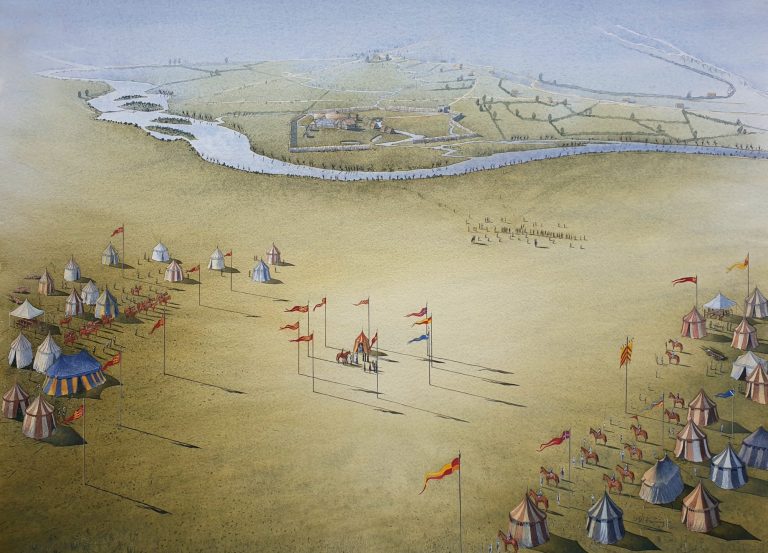
15th June 1215
Artist Impression by Phil Kenning showing the meeting on Runnymede between King John and The Barons.
The assembly of men would have attracted a vast crowd. Occupants from Egham, Staines and Wraysbury would have gathered to watch.
King John quickly appealled to the Pope, citing that he had been forced to agree to the terms of the Charter, and in August 1215 Pope Innocent XIII annuls Magna Carta.
This infuriated the Barons, who took matters into their own hands, and looked for credible solutions to their situation.

King John Sealing Magna Carta
This image, like so many, shows King John holding a Quill, and yet it should be his great seal that was used to validate Magna Carta.

Magna Carta (British Library)
The 63 Clauses partially helped shape modern democracy today

Why Runnymede?
Here are some likely reasons why the Meadow was chosen
However, there is great speculation over the exact location of the sealing of Magna Carta. This is fuelled by the absence of a key word in the original document - that of the County in which Magna Carta was sealed.
At the bottom of this page, this aspect will be discussed.
The First Barons' War
1215-1217
Unhappy with King John, the Barons look to their homeland for support. This came in the support of Prince Louise. He was the son of Philip II of France, and was later to become King Louis VIII of France.
Prince Louis was a natural choice for the Barons, as he was married to Blanche of Castile, daughter of King Alfonso VIII of Castile and Eleanor of England, second daughter of Henry II. Arriving unopposed on the Isle of Thanet in May 1216 Louis and his army marched on London. He was proclaimed King of England at St Paul's Cathedral (though never crowned). By July, 'King' Louis had seized Canterbury, Reigate, Farnham, and Guildford castles and captured Winchester, controlling much of Southern England. King John, meanwhile had retreated westwards, to avoid conflicts and loyal Barons managed to retain both Dover and Rochester, preventing further French troops safe passage.
With Winter shortly looming, and a stalemate likely, things took a dramatic turn, because Kign John suddenly died, of dysentery. Initially, from the point of view of Prince Louis, this made things much easier for him, however for the Barons, no so: They now had a choice to make. Do they support the ambitious French Prince, or should they look to the young successor - King Henry III. Henry, only 9 years old was governed by William Marshall 1st Earl of Pembroke, as Lord Protector. To aid in their decision, Magna Carta was reissued in November 1216, which was clever move by Marshall.
It had the desired effect, and by the following Spring, many barons changed sides and fought for Henry against Prince Louis' claim. Marshal called all nobles holding castles in England to a muster in Newark. In May of 1217 some 400 knights, 250 men armed with crossbows, and a force of mounted and foot soldiers marched upon Lincoln. Here they advanced on the forces of Louis, who had laid siege to Lincoln Castle, and defeated, the French retreated towards London.
However, all was not lost for Louis, as he sent word to his wife, Blanch, to supply ships with troops to reinforce his campaign. Over 80 vessels set sail, including 11 troopships, but were met by English Vessels off the coast of Sandwich in August of 1217. Despite being out numbered 2:1, the English out manoeuvred the French, and captured or sunk 3/4s of the foreign ships. Nine of the troopships returned to France, and Louis, now cut off from France was in a desperate situation.
William Marshall, however stepped in and offered Louis at truce, and this was instigated between Staines and Kingston in September 1217. The Treaty of Lambeth, involving Henry III, William Marshall, Prince Louis and Barons and Knights from both sides, met on September 12th, where Pricne Louis was paid £10,000 marks and given safe passage back to Dover. It was conditional wherein Louis would agree to renounce his claims to the English Throne.
This act ended the First Barons' War, and some years later in 1225, Henry III issues a much smaller Charter, containing just 37 clauses, many based upon the original 1215 larger Charter. It is only after 1225 that the Runnymede Charter is named Magna (or Great) Charter, to distinguish it from this later Charter.

So, where was Magna Carta Sealed in June 1215?
There are no contemporary accounts of the meeting. The earliest descriptions date from the decades after 1215 which were written by medieval chroniclers Matthew Paris and Roger Wendover. They both cite the events occurred on Runnymede. During the 16th and 17th century further texts were written (Eg Polidore Vergil’s English History 1584, and Aubrey's History of Surrey 1673). With each account, the content grows in details.
However it is during the 18th and 19th century that much more was written. In 1834 an island in the Thames was altered from a fisherman's house to a Gothic Folly, and called Magna Carta House. Complete with a hexagonal table, taken from Ankerwycke House, a ferry took enquiring visitors to see the Charter Room.
In the 1860s, when Ordnance Surveyors compiling maps of the area, they recorded that Runnymede was where the Barons were encamped, and on the Island was where Magna Carta was sealed.
Furthermore, some suggest it was under the great Yew at Ankerwycke.
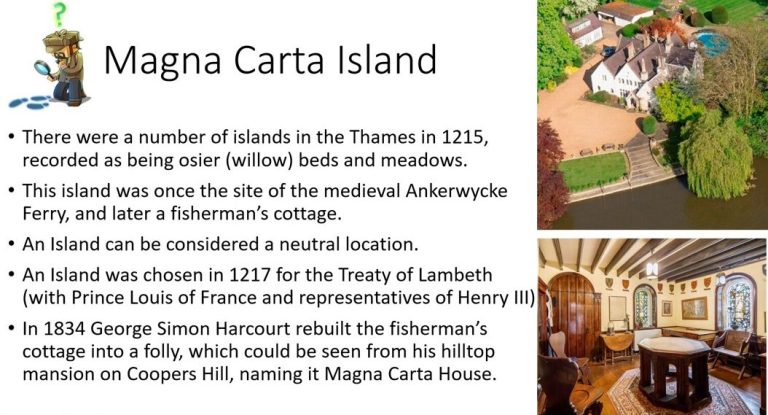
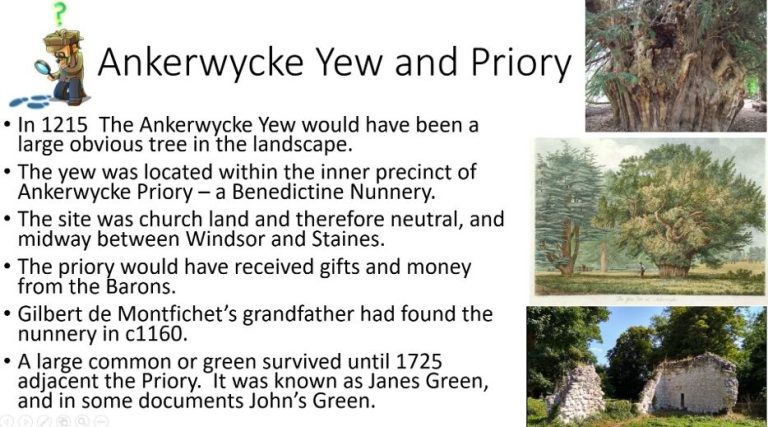
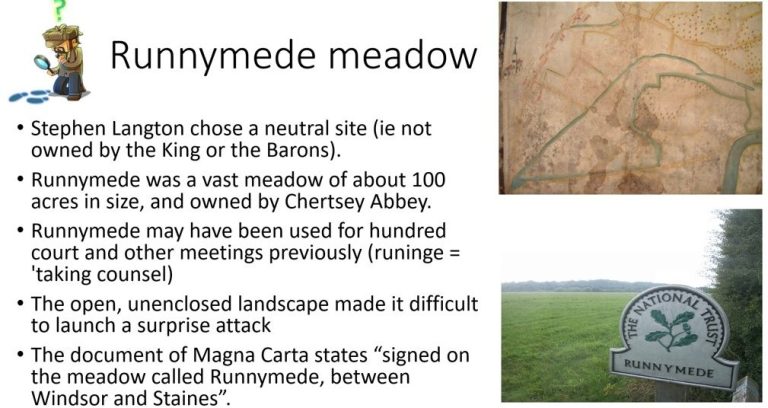
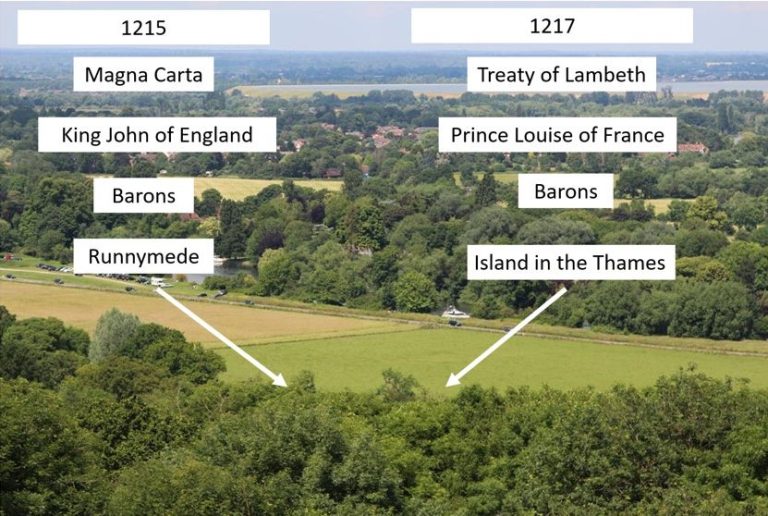
Why the Confusion?
The reason for an island being introduced to the Runnymede story is largely based upon 2 events occurring in close proximity to each other.
Both events involve a King. Both events involve barons. Both events involve a Charter.
As history was -more often than not- passed down orally, it can very quickly be seen how two completely separate events eventually become one event.
Furthermore the notion that County Boundaries have changed is grossly wrong, as these were established by the 9th century. However there is some truth in the fact that Runnymede is likely to have had tributaries of the Thames around it, but the county boundary ran along the line of the present, Thames, with several orginal islands - belonging to Buckinghamshire, now land-locked on the Surrey side.
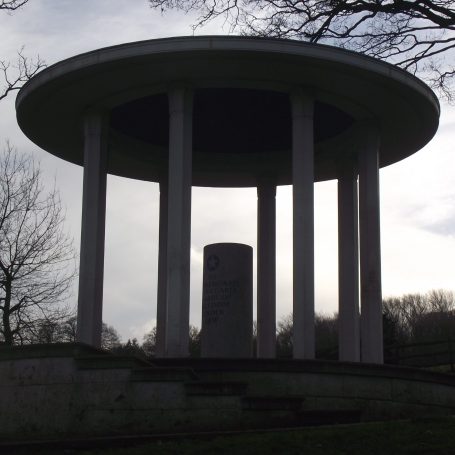

//
//
© Copyright. All rights reserved.
We need your consent to load the translations
We use a third-party service to translate the website content that may collect data about your activity. Please review the details in the privacy policy and accept the service to view the translations.
